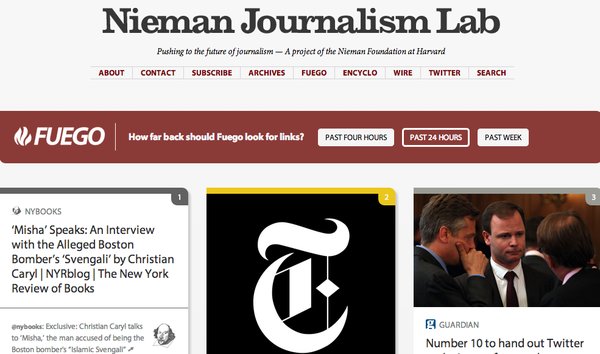Brands
New Wave of Curation Platforms Hit Targeted Audiences
There is more to content marketing than writing for Google’s robots. A new wave of sites based on topic curation, both human and algorithmic, are creating opportunities to reach targeted audiences — if you know what these new hybrid curators are really looking for.
Three examples, Fuego, Upworthy and Prismatic, reveal a range of approaches to presenting compelling content to a given audience. On one end of the curation spectrum is a focus on specific topics and sub-topics and on the other is content selected by specific types of people.

Fuego, to start, is really just the product of a very specific social graph — the people on Twitter whom The Nieman Journalism Lab at Harvard has identified as thought leaders on the future of journalism. Fuego use an algorithm-powered engine to tracks and share the most popular links on Twitter circulating between this set of users.
“The beauty of using an algorithm is in its scalability,” says Toronto-based tech blogger and marketing specialist, Herbert Lui. “While Fuego currently tracks only the journalism-related segment of Twitter users, a completely different segment of users would lead to a completely different set of user-generated links, and a completely different set of articles. Fuego could just as easily be used to track tech news or fashion trends.”
“The beauty of using an algorithm is in its scalability.”
There are two human aspects to Fuego’s curation, the selection of the people to include in the set of users and then the choices of which links to tweet by those users. Beyond the initial setup, though, all that is required to manage the site is the periodic validation of existing users and the adding of new ones — the users themselves do the rest.
For content marketers, this kind of scheme readily identifies the influencers within topic and sub-topic areas and makes it easier to target relevant stories to them.
Upworthy is literally socially-minded. It was co-founded by Eli Pariser, author of The Filter Bubble (a must-read for anyone interested in curation) and before that executive director of the left-leaning advocacy group MoveOn.org. Think of this as psychographic curation. Upworthy is not for everyone — on purpose. If you oppose gay marriage, deny the validity of climate change or vote Republican, this is not the curator for you.

Although the 2012 Presidential election was the catalyst to start Upworthy, politics, per se, have not driven its hockey stick growth curve. The site is powered by human curators augmented with a quantitative toolset that drives pageviews. “We have our team of curators spending all their time looking on the Internet for stuff,” says Pariser.
“We go for visible, sharable stories and really stay away from doing more typical, text-driven articles and blogging,” Pariser told Business Insider recently. “We lean into images and videos.”
“A good headline can be the difference between 1,000 people and 1,000,000 people reading something.”
They have learned to highlight stories that are already generating conversations, particularly on Facebook. Upworthy’s curators are not just aggregators but repackagers who write 25 headlines for each story and then A/B test them to find the best. “A good headline can be the difference between 1,000 people and 1,000,000 people reading something,” says Pariser. Publishers can learn a few things from how their own stories are recast on Upworthy.
“Through rigorous testing and analysis, Upworthy is beginning to cut its own key to virality,” says Lui, “and is using that key to direct attention to social issues rather than the latest celebrity gossip (or cat videos.)”
If you are interested in its audience, Upworthy’s daily emails are a great way to keep in touch with their most passionate concerns.

Prismatic is the longest on machine learning and the shortest on human intervention of these three curation models. More of an app than a site (currently available for iOS and on the web, but an Android version is in the works), it builds a profile of each user through stated interests and selected news sources as well as social media accounts and interaction history with the site itself.
The problem with individualized curation sites in the past, Lui explains, is that “People had to invest a significant amount of time before the social discovery service calibrated to their tastes. By parsing through a user’s Twitter and Facebook accounts, Prismatic attempts to break the barrier down and make content a lot more relevant the first time a user logs in.”
In actual practice, though, Prismatic can throw some clunkers into the mix by mistaking a person’s friends on social media with their actual, like-minded “content friends.” Its ambitions as a universal and wholly automated solution have led to a beautiful but complex product that is nowhere as reliable as the more localized and human-enabled models championed by Fuego and Upworthy.
Perhaps the most useful lesson from Prismatic is that — like politics — all curation is, indeed, local. Lui concludes that, “Curation has evolved into the yin to content’s yang,” and content producers ignore it at their peril.
Curation models are mirrors that validate our own efforts and remind us of how important it is to know your audience.

Get better at your job right now.
Read our monthly newsletter to master content marketing. It’s made for marketers, creators, and everyone in between.




